Last Updated on 6 months by Francis
When it comes to light-based therapies, two popular options are red light therapy and chromotherapy. While they may seem similar at first glance, there are significant differences between the two.
Red light therapy involves using specific wavelengths of red light to stimulate cellular activity, while chromotherapy employs different colors of light to balance energy and enhance well-being. By understanding the key differences between these modalities, you can make an informed decision about which treatment is best for you.
Contents
Key Takeaways:
- Red light therapy and chromotherapy are light-based therapies that differ in their approach and intended outcomes.
- Red light therapy uses red light wavelengths to stimulate cellular activity and promote skin health, pain relief, and wound healing.
- Chromotherapy uses different colors of light to balance energy and enhance mood, sleep, and overall well-being.
- Choosing the right treatment depends on your specific needs and goals, so consult with a healthcare professional or wellness expert for personalized recommendations.
- It’s worth noting that red light therapy and chromotherapy can also be used in combination for potential synergistic effects.
What is Red Light Therapy?
Red light therapy, also known as photobiomodulation, is a non-invasive treatment that uses specific wavelengths of red light to stimulate cellular activity.
This type of therapy has been shown to have various benefits, including improved skin health, reduced pain and inflammation, and accelerated wound healing.
The red light penetrates the skin and stimulates the mitochondria in cells, leading to increased energy production. This, in turn, promotes cellular repair and rejuvenation.
Red light therapy is often used for skin health, as it helps boost collagen production and reduce signs of aging and acne. It is also used for pain relief, particularly for muscle aches and joint pain.
Additionally, studies have shown that red light therapy may have potential mood-enhancing effects. Overall, this therapy provides a safe and effective means of supporting overall health and well-being.

Red light therapy can help improve skin health, reduce pain and inflammation, and promote wound healing.
How Does Red Light Therapy Work?
Red light therapy, also known as photobiomodulation, works by using specific wavelengths of red light to penetrate the skin and stimulate the mitochondria in cells.
When the red light reaches the cells, it increases energy production, leading to cellular repair and rejuvenation. This process can have numerous benefits, including improved skin health, reduced inflammation and pain, and accelerated wound healing.
The specific wavelength used in red light therapy can vary depending on the desired outcome. For example, red light therapy for skin health typically uses a wavelength of around 630-700 nanometers to stimulate collagen production and improve skin texture and tone. Red light therapy for pain relief, on the other hand, often uses a slightly longer wavelength of 810-850 nanometers to target deeper tissue and muscle pain.
Overall, red light therapy works by harnessing the power of specific wavelengths of light to promote cellular activity and support various aspects of health and well-being.

How Does Red Light Therapy Compare to Other Light-Based Therapies?
While red light therapy is often used interchangeably with terms like low-level laser therapy (LLLT) and photobiomodulation (PBM), there are some key differences between these light-based treatments.
For example, LLLT typically uses more intense and focused light, while PBM generally uses broader wavelengths and lower intensities.
However, despite these differences, all of these light-based therapies share the common goal of utilizing light energy to support cellular activity and promote healing, making them valuable additions to any wellness routine.
Tip: When receiving red light therapy treatments, be sure to wear protective eyewear to prevent potential damage to the eyes from the bright light.
What is Chromotherapy?
Chromotherapy, also known as color therapy, is a holistic healing practice that uses colors to balance energy and enhance well-being. It is based on the belief that different colors have different vibrations and can influence our emotions, mood, and overall health.
Chromotherapy has been practiced for centuries, with ancient cultures like the Egyptians and Greeks using colored minerals, stones, and dyes for therapeutic purposes. Today, chromotherapy is used in various fields, including Western medicine, alternative medicine, and interior design.
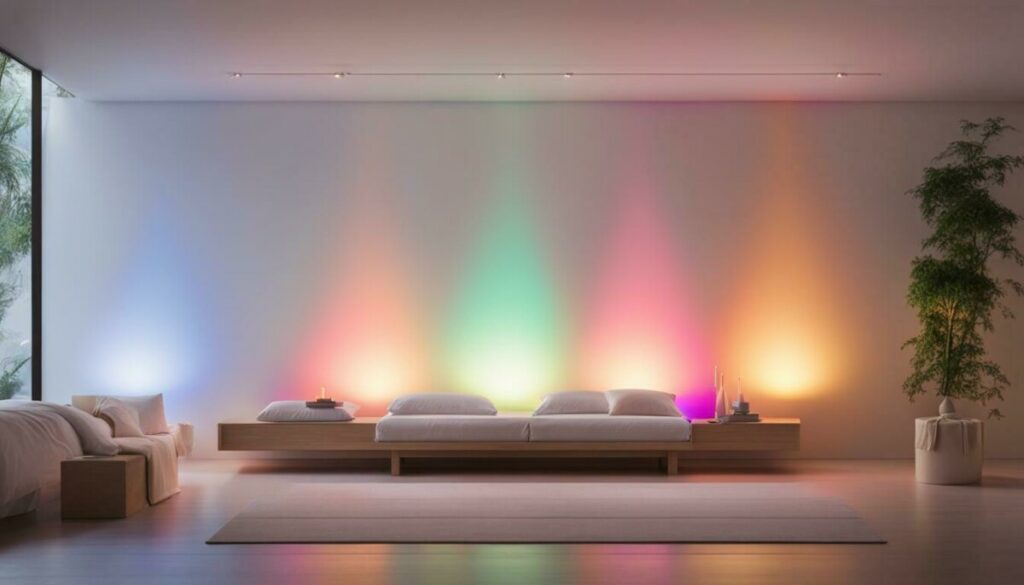
“Chromotherapy harnesses the power of colors to promote physical, emotional, and spiritual balance.”
The goal of chromotherapy is to bring balance and harmony to the body, mind, and spirit by using colors that are associated with specific properties and effects. Each color is believed to have its unique energy and impact on our physical, emotional, and spiritual well-being.
The Benefits of Chromotherapy
Chromotherapy offers a range of potential benefits, including:
- Mood Enhancement: Certain colors are believed to promote feelings of calmness, relaxation, and happiness, helping to alleviate stress, anxiety, and depression.
- Stress Reduction: Chromotherapy can help reduce stress and tension by balancing the body’s energy and promoting relaxation.
- Improved Sleep Quality: Some colors are associated with creating a soothing and calming environment that can improve sleep quality.
- Increased Energy Levels: Colors like orange and yellow are believed to boost energy and stimulate the mind, making them suitable for use in workspaces and areas of study.
- Overall Well-being: Chromotherapy is thought to provide overall health benefits by promoting balance and harmony throughout the body and mind.
While scientific research on chromotherapy is still limited, many people report positive results from using color therapy as a complementary treatment for various health issues.
In the next section, we will explore how chromotherapy works and the different ways it can be practiced.
How Does Chromotherapy Work?
Chromotherapy, also known as color therapy, is a holistic healing practice that uses colors to balance energy and enhance well-being. It is based on the belief that different colors have different vibrations and can influence our emotions, mood, and overall health.
Chromotherapy involves exposing individuals to specific colors of light, either through colored light bulbs, colored filters, or natural light sources. Each color is believed to have unique properties and can affect different aspects of our being, such as mental and emotional states. For example, blue light is often used for relaxation and calming, while yellow light is associated with promoting mental clarity and focus.
Proponents of chromotherapy believe that by exposing the body to certain colors, it can help to balance energy and restore well-being. Some practitioners use chromotherapy in conjunction with other therapies, such as massage or acupuncture, to enhance their effects.

While research on chromotherapy is ongoing, some studies have suggested that it may have beneficial effects on mood, stress, and overall well-being. However, more research is needed to fully understand the potential benefits and mechanisms of this practice.
Key Differences between Red Light Therapy and Chromotherapy
While both red light therapy and chromotherapy are light-based treatments, they differ in their approach and intended outcomes. Red light therapy primarily focuses on the specific wavelengths of red light and their effects on cellular activity, while chromotherapy encompasses a broader spectrum of colors and their impact on emotional and mental well-being.
Red light therapy is often used for skin health, reducing pain and inflammation, and wound healing. Chromotherapy, on the other hand, is commonly associated with mood enhancement, stress reduction, and improved sleep quality.
Red light therapy and chromotherapy also differ in the mechanisms of action. Red light therapy works by penetrating the skin and stimulating the mitochondria in cells, leading to increased energy production and cellular repair. Chromotherapy, on the other hand, involves exposing individuals to specific colors of light, believed to affect different aspects of our being, such as emotional states and mental well-being.
Overall, the choice between red light therapy and chromotherapy depends on your specific needs and goals. If you want to focus on skin health or pain relief, red light therapy may be the better option. Choosing chromotherapy can offer mood enhancement and emotional balance. However, you can also consider combining both therapies to experience the potential benefits of both red light therapy and chromotherapy.

Red light therapy primarily focuses on the specific wavelengths of red light and their effects on cellular activity, while chromotherapy encompasses a broader spectrum of colors and their impact on emotional and mental well-being.
Benefits of Red Light Therapy
Red light therapy has gained popularity in recent years as a non-invasive, drug-free alternative to conventional treatments. Its benefits have been extensively studied and documented, with scientific evidence supporting its potential to improve overall health and well-being.
One of the most significant benefits of red light therapy is its ability to enhance skin health. Research has shown that red light therapy can stimulate collagen production, reduce fine lines and wrinkles, and improve overall skin tone and texture. This makes it a popular treatment option for those looking to improve their skin’s appearance without invasive procedures.
Additionally, red light therapy has been shown to have anti-inflammatory effects, making it a promising treatment option for pain relief. It has been used to reduce pain and stiffness associated with arthritis, muscle soreness, and other chronic conditions. It may also promote tissue repair and wound healing by increasing circulation and reducing inflammation in affected areas.
Some studies have also suggested that red light therapy may have mood-enhancing effects, potentially reducing symptoms of depression and anxiety. This may be due to its ability to increase blood flow to the brain and stimulate the production of endorphins, the body’s natural “feel-good” chemicals.
Overall, red light therapy is a low-risk, non-invasive treatment that can potentially improve skin health, reduce pain and inflammation, and promote overall well-being.

When seeking out a red light therapy treatment, it’s essential to do your research and work with a qualified healthcare professional or wellness practitioner to ensure a safe and effective experience.
Benefits of Chromotherapy
Chromotherapy, also known as color therapy, is an alternative healing practice that uses colors to promote physical, emotional, and mental well-being. Here are some of the potential benefits of chromotherapy:
- Mood enhancement: Different colors are believed to elicit specific emotional responses, with warm colors like reds and oranges associated with excitement and energy, while cool colors like blues and greens are associated with relaxation and calmness.
- Stress reduction: Certain colors can help reduce stress and anxiety, such as blue, purple, and pink hues.
- Improved sleep quality: Blue light exposure has been shown to regulate the production of melatonin, a hormone that regulates sleep-wake cycles.
- Increased energy levels: Yellow light is often used to promote mental clarity and alertness, making it a popular choice for boosting energy levels.
- Overall well-being: By balancing the energy in different parts of the body, chromotherapy is believed to support overall physical and emotional health.
While more research is needed to establish definitive conclusions, many people have reported positive experiences and improved well-being through chromotherapy.

Choosing the Right Treatment for You
Deciding whether to choose red light therapy or chromotherapy depends on your specific wellness needs and goals. While both modalities offer potential benefits, they differ in their approach and intended outcomes.
If you’re primarily seeking pain relief or skin health improvements, red light therapy may be the better choice. Red light therapy stimulates cellular activity through red light wavelengths, promoting cellular repair and rejuvenation. It has been shown to improve skin health, reduce inflammation and pain, and accelerate wound healing. On the other hand, if you’re looking for emotional balance or mood enhancement, chromotherapy may be more suitable.
Chromotherapy uses specific colors to balance energy and enhance well-being. Different colors have unique properties and can influence our emotions, mood, and overall health. For example, blue light is often used for relaxation and calming, while yellow light is associated with promoting mental clarity and focus.
Ultimately, the choice between red light therapy and chromotherapy depends on your specific needs and goals. Consider what resonates with you and seek guidance from a healthcare professional or wellness expert to determine which treatment is best suited to support your well-being.

Combining Therapies
It’s worth noting that red light therapy and chromotherapy can be used in combination, and some wellness centers offer treatments that incorporate both modalities, allowing you to experience the potential benefits of both red light therapy and chromotherapy simultaneously.
Safety Precautions and Side Effects
While both red light therapy and chromotherapy are generally considered safe, it’s important to follow recommended guidelines and consult with a healthcare professional if you have any specific health conditions or concerns. Side effects are minimal but might include temporary skin redness or eye sensitivity.
Research and Evidence
Research on both red light therapy and chromotherapy is ongoing, with studies exploring their effectiveness and potential applications in various health conditions. While some studies have shown promising results, more research is needed to establish definitive conclusions.
Integrating Light Therapy into Your Wellness Routine
Whether you choose red light therapy, chromotherapy, or a combination of both, integrating light therapy into your wellness routine can be a valuable addition. Consistency and regularity play a significant role in experiencing potential benefits, so aim to incorporate light therapy into your routine in a way that works for you.
Empower Your Wellness Journey
By understanding the differences between red light therapy and chromotherapy, you can make an informed decision about which treatment aligns with your specific wellness goals. Remember to consider your unique needs, preferences, and desired outcomes, and seek guidance from a qualified healthcare professional or wellness practitioner to help you make the best decision.
Ultimately, whether you choose red light therapy or chromotherapy, or a combination of both, both modalities can complement your wellness journey and support your overall health and well-being.
Considering Combination Therapies
Red light therapy and chromotherapy can be used together to enhance their potential benefits. By blending the cellular benefits of red light therapy with the emotional balancing of chromotherapy, you can create a more holistic approach to your well-being.

Some wellness centers offer treatments that incorporate both modalities, providing you with a unique experience that can address multiple aspects of your health and well-being. By combining red light therapy and chromotherapy, you can potentially boost your mood, reduce pain and inflammation, and improve your skin health all at once.
When considering combination therapies, it’s important to work with a qualified healthcare professional or wellness expert to ensure that the treatment is suitable for you. Some individuals may have specific health conditions or concerns that may not be compatible with certain treatments.
Safety Precautions and Side Effects
While both red light therapy and chromotherapy have proven to be safe and non-invasive treatments, it is essential to follow recommended guidelines and seek professional advice before starting any new treatment.
For red light therapy, it is recommended to wear protective eyewear to prevent exposure to harmful radiation. Additionally, patients with photosensitivity or those taking medication that increases sensitivity to light should avoid this treatment.
As for chromotherapy, it is generally considered safe, but some individuals may experience adverse reactions. For instance, exposure to red or yellow light could trigger migraines in susceptible individuals, while blue light may cause eyestrain or disrupt sleep patterns.
It is crucial to consult with a healthcare professional before undergoing any new treatment. They can help you understand the potential risks and benefits and guide you towards the best treatment option for your specific needs.
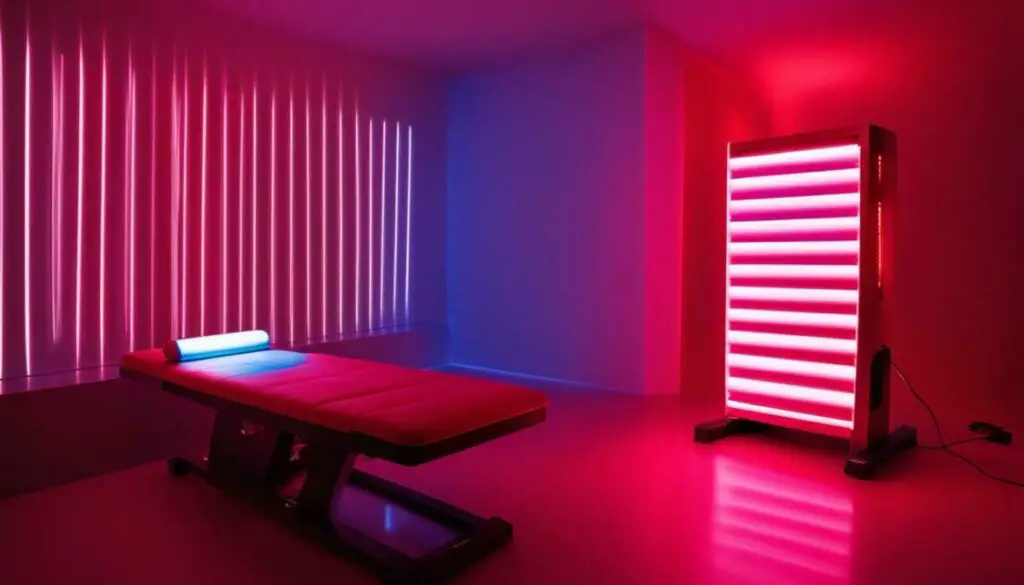
Research and Evidence
Research on the efficacy of red light therapy and chromotherapy is ongoing, with scientists and healthcare professionals exploring their potential applications in various health conditions. Some studies have shown promising results, but more research is needed to establish definitive conclusions.
Scientific studies suggest that red light therapy may have anti-inflammatory effects, making it potentially useful in treating conditions such as osteoarthritis, rheumatoid arthritis, and other musculoskeletal disorders. A study published in the Journal of Cosmetic and Laser Therapy found that red light therapy was effective in reducing the appearance of wrinkles and fine lines while improving skin texture and tone.
Similarly, chromotherapy has been studied for its potential effects on mood and emotional well-being. A systematic review published in the Journal of Evidence-Based Integrative Medicine found that chromotherapy may be effective in reducing symptoms of depression and anxiety.
While research on both red light therapy and chromotherapy is ongoing, it’s essential to seek guidance from a qualified healthcare professional or wellness practitioner before beginning any new treatment.

Seeking Professional Guidance for Red Light Therapy and Chromotherapy
When considering incorporating red light therapy and chromotherapy into your wellness routine, it’s crucial to seek professional guidance. Consult with a qualified healthcare professional or wellness expert who can assess your individual needs and provide personalized recommendations. They can also help you determine whether red light therapy, chromotherapy, or a combination of both treatments may be most suitable for achieving your wellness goals.
Professional guidance is particularly crucial if you have any specific health conditions or concerns or are currently taking any medications that could potentially interact with light therapy. A healthcare professional can help you understand the potential risks and benefits of these treatments and offer personalized guidance to support your overall health and well-being.
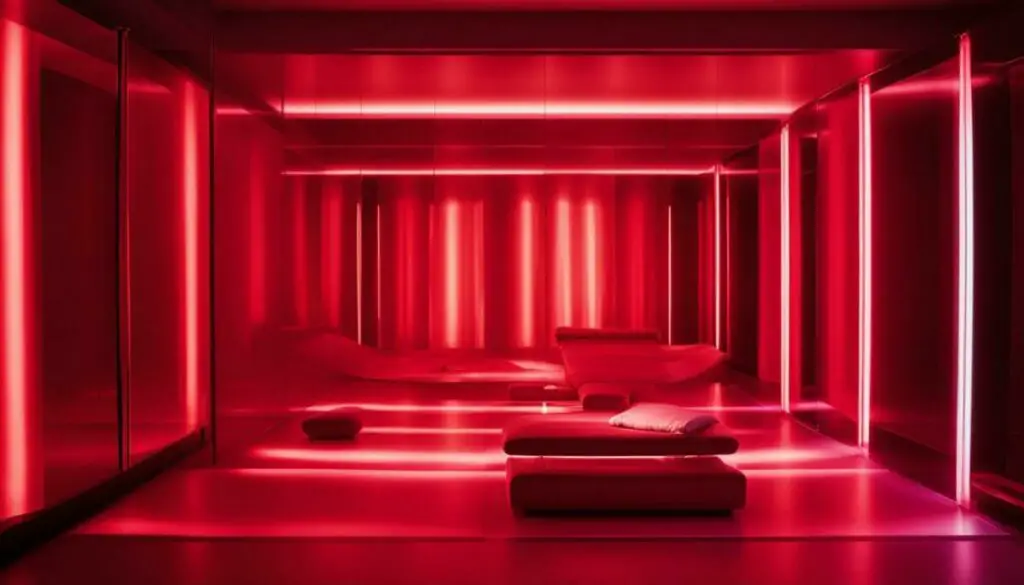
Keep in mind that while light therapy is generally safe, it’s essential to follow recommended guidelines and seek professional guidance to ensure you’re using these treatments safely and effectively.
“Professional guidance is crucial to ensure you’re using these treatments safely and effectively.”
Integrating Light Therapy into Your Wellness Routine
Whether you opt for red light therapy, chromotherapy, or both, incorporating light therapy into your wellness routine can be a valuable addition. By taking a proactive approach to your health, you can experience potential benefits and enhance your overall well-being.
One way to integrate light therapy into your routine is to schedule regular sessions at a wellness center or spa that offers red light therapy or chromotherapy treatments. These sessions typically range from 20 to 30 minutes and can be an excellent opportunity to relax and unwind while reaping the potential benefits of light therapy.
If you prefer to have access to light therapy treatments at home, there are several affordable options for at-home light therapy devices. These include handheld red light therapy wands, light therapy masks, and light therapy lamps. Before purchasing any devices, be sure to research their safety and efficacy and consult with a healthcare professional if you have any concerns.
In addition to scheduled sessions or at-home devices, you can also integrate light therapy into your daily routine by practicing mindfulness and incorporating meditation, deep breathing, or yoga. These practices can help reduce stress and promote relaxation, complementing the potential mood-enhancing effects of chromotherapy.
| Red Light Therapy Benefits | Chromotherapy Benefits |
|---|---|
|
|
Integrating light therapy into your wellness routine can provide a multitude of benefits, depending on the treatment modality you choose and your specific health needs. By taking the time to understand your options and consult with a healthcare professional, you can make informed decisions about how to best support your well-being.
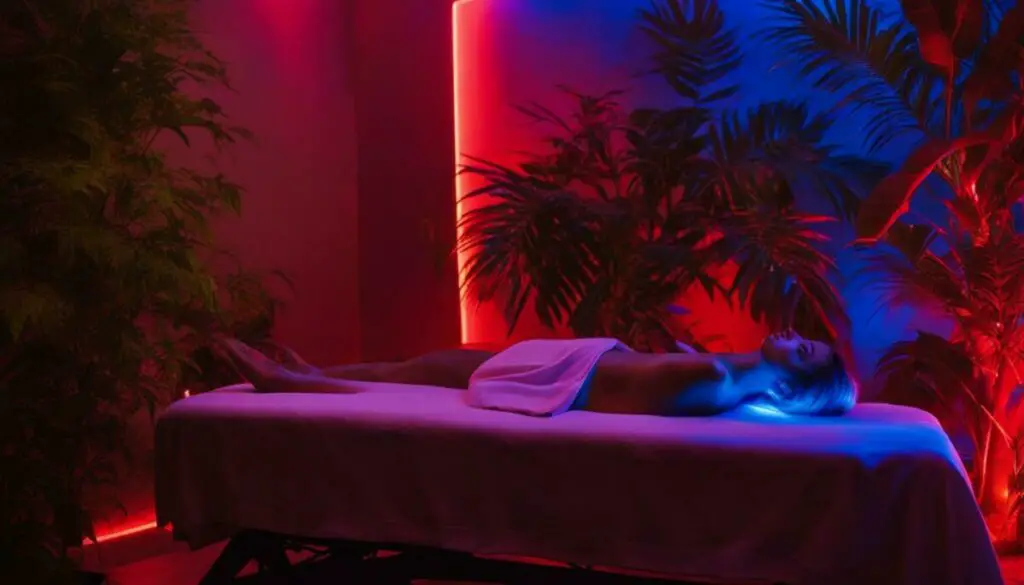
Empower Your Wellness Journey
As you navigate the world of alternative therapies, it’s important to approach your wellness journey with an open mind and a willingness to explore your options. Whether you decide to try red light therapy, chromotherapy, or both, remember that different modalities work for different people. What may work for your friend or family member may not necessarily be the best fit for you.
By educating yourself on the differences between red light therapy and chromotherapy, you’re taking an important step towards making a decision that aligns with your specific needs and goals. Keep in mind that these treatments are not intended to replace traditional medical care, but rather to complement it.
Remember to consult with a healthcare professional or wellness practitioner before starting any new treatment, and always follow recommended guidelines for safety and best results.
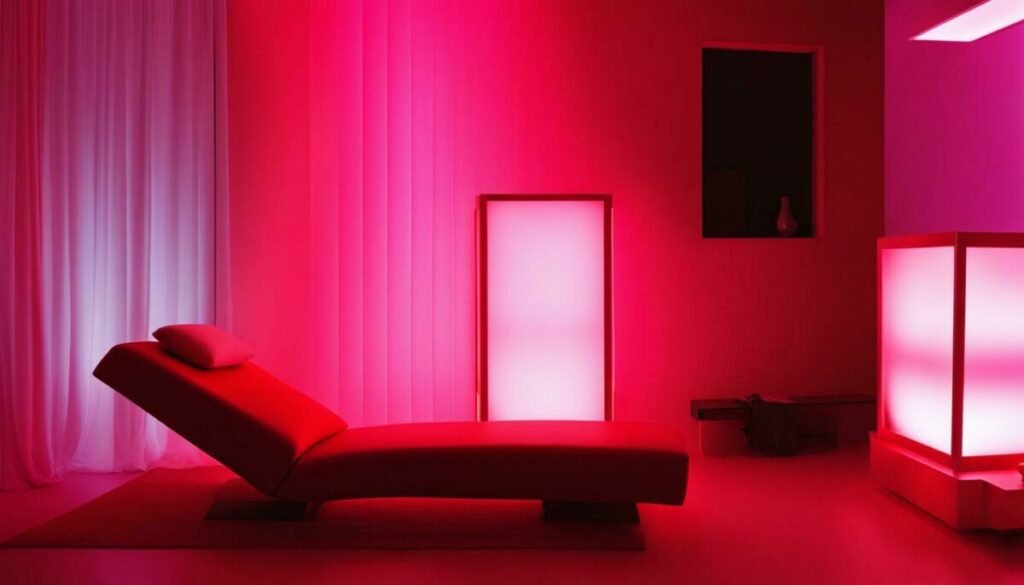
Integrating light therapy into your wellness routine can be a valuable addition, providing potential benefits for both physical and emotional health. Whether you choose red light therapy for its cellular benefits or chromotherapy for mood enhancement, consistency and regularity are key to experiencing positive effects.
Ultimately, the decision between red light therapy and chromotherapy is a personal one, based on your unique needs and goals. By taking charge of your well-being and exploring alternative therapies, you’re empowering yourself to live a healthier, happier life.
Red Light Therapy vs Chromotherapy: Making the Right Choice for Your Health
Deciding between red light therapy and chromotherapy can feel overwhelming, but armed with knowledge, you can make a well-informed choice. Both modalities can offer benefits for your body and mind, but they differ in their approach and intended outcomes. Here’s what you need to know to make the right decision for your health.
Understanding the Differences
Red light therapy and chromotherapy vary in their methodology and primary focus. Red light therapy uses specific wavelengths of red light to stimulate cellular activity, resulting in improved skin health, reduced pain, and accelerated wound healing. Chromotherapy, on the other hand, uses colors to balance energy and enhance wellbeing, with each color believed to evoke specific emotional and physical responses.
Considering Your Needs
Deciding which treatment to choose depends on your specific wellness needs and goals. If you’re looking to relieve pain or improve skin health, red light therapy may be the better option for you. In contrast, if you’re looking to enhance your mood or promote emotional balance, chromotherapy may be more suitable.
Combining Therapies
Keep in mind that red light therapy and chromotherapy can also be used in combination for a more holistic approach. Some wellness centers offer treatments that incorporate both modalities, allowing you to potentially benefit from their unique properties simultaneously.
Seeking Professional Guidance
It’s essential to seek guidance from a healthcare professional or wellness practitioner before starting any new treatment. They can help assess your individual needs and provide personalized recommendations to help you choose the best therapy for your health.
Integrating Light Therapy into Your Wellness Routine
Whether you choose red light therapy, chromotherapy, or a combination of both, integrating light therapy into your wellness routine can provide a valuable addition. Try to maintain consistency and regularity in your treatments for maximum benefits.
In conclusion, the choice between red light therapy and chromotherapy depends on your specific wellness needs and goals. Consider what resonates with you and seek professional guidance to help choose the best therapy for your health. With informed decision-making and a commitment to consistency, light therapy can be a powerful tool in your wellness journey.
FAQ
What is the difference between red light therapy and chromotherapy?
Red light therapy primarily focuses on using specific wavelengths of red light to stimulate cellular activity, promoting various benefits such as improved skin health and pain relief. Chromotherapy, on the other hand, uses different colors of light to balance energy and enhance well-being, targeting emotional and mental states.
What is red light therapy?
Red light therapy, also known as photobiomodulation, involves using specific wavelengths of red light to stimulate cellular activity. This non-invasive treatment has been shown to have various benefits, including improving skin health, reducing pain and inflammation, and promoting wound healing.
How does red light therapy work?
Red light therapy works by penetrating the skin and stimulating the mitochondria in cells, leading to increased energy production. This promotes cellular repair and rejuvenation. The specific wavelength used in red light therapy can vary depending on the desired outcome, such as collagen production for skin health or pain relief for muscle aches.
What is chromotherapy?
Chromotherapy, also known as color therapy, is a holistic healing practice that uses colors to balance energy and enhance well-being. It is based on the belief that different colors have different vibrations and can influence our emotions, mood, and overall health.
How does chromotherapy work?
Chromotherapy involves exposing individuals to specific colors of light, either through colored light bulbs, colored filters, or natural light sources. Each color is believed to have unique properties and can affect different aspects of our being, such as mental and emotional states. For example, blue light is often used for relaxation and calming, while yellow light is associated with promoting mental clarity and focus.
What are the key differences between red light therapy and chromotherapy?
While both red light therapy and chromotherapy are light-based treatments, they differ in their approach and intended outcomes. Red light therapy focuses on the specific wavelengths of red light and their effects on cellular activity. Chromotherapy encompasses a broader spectrum of colors and their impact on emotional and mental well-being.
What are the benefits of red light therapy?
Red light therapy has been associated with various benefits, including improved skin health by boosting collagen production, reduced inflammation and pain through its anti-inflammatory effects, accelerated wound healing, and potential mood enhancement.
What are the benefits of chromotherapy?
Chromotherapy has been linked to numerous benefits, such as mood enhancement, stress reduction, improved sleep quality, increased energy levels, and overall well-being. Different colors are believed to elicit specific emotional and physical responses, providing support for various aspects of our health.
How do I choose the right treatment for me?
Deciding between red light therapy and chromotherapy depends on your specific needs and goals. If you’re primarily seeking skin health improvements or pain relief, red light therapy may be the better choice. On the other hand, if you’re looking for mood enhancement or emotional balance, chromotherapy might be more suitable.
Can I combine red light therapy and chromotherapy?
Yes, red light therapy and chromotherapy can be used in combination. Some wellness centers offer treatments that incorporate both modalities, allowing you to experience the potential benefits of both red light therapy and chromotherapy simultaneously.
What are the safety precautions and side effects of these therapies?
While both red light therapy and chromotherapy are generally considered safe, it’s essential to follow recommended guidelines and consult with a healthcare professional if you have any specific health conditions or concerns. Side effects are minimal but might include temporary skin redness or eye sensitivity.
Is there any research and evidence supporting these therapies?
Research on red light therapy and chromotherapy is ongoing, with studies exploring their effectiveness and potential applications in various health conditions. While some studies have shown promising results, more research is needed to establish definitive conclusions.
Should I seek professional guidance before starting these treatments?
Before starting any new treatment, it’s always advisable to seek guidance from a qualified healthcare professional or wellness practitioner who can assess your individual needs and provide personalized recommendations.
How can I integrate light therapy into my wellness routine?
Whether you choose red light therapy, chromotherapy, or a combination of both, integrating light therapy into your wellness routine can be a valuable addition. Consistency and regularity play a significant role in experiencing potential benefits, so incorporating it regularly is key.
How can understanding the differences empower my wellness journey?
Understanding the differences between red light therapy and chromotherapy empowers you to make informed decisions about which treatment aligns with your specific wellness goals. By considering your unique needs, preferences, and desired outcomes, you can take charge of your well-being.
How do I make the right choice for my health?
Red light therapy and chromotherapy offer unique approaches to supporting overall health and well-being. Whether you choose red light therapy for its cellular benefits or chromotherapy for emotional balance, both modalities can complement your wellness journey. Ultimately, the choice between red light therapy and chromotherapy depends on your specific needs and goals, so consider what resonates with you and consult with a healthcare professional or wellness expert to guide you towards the best treatment option for you.








